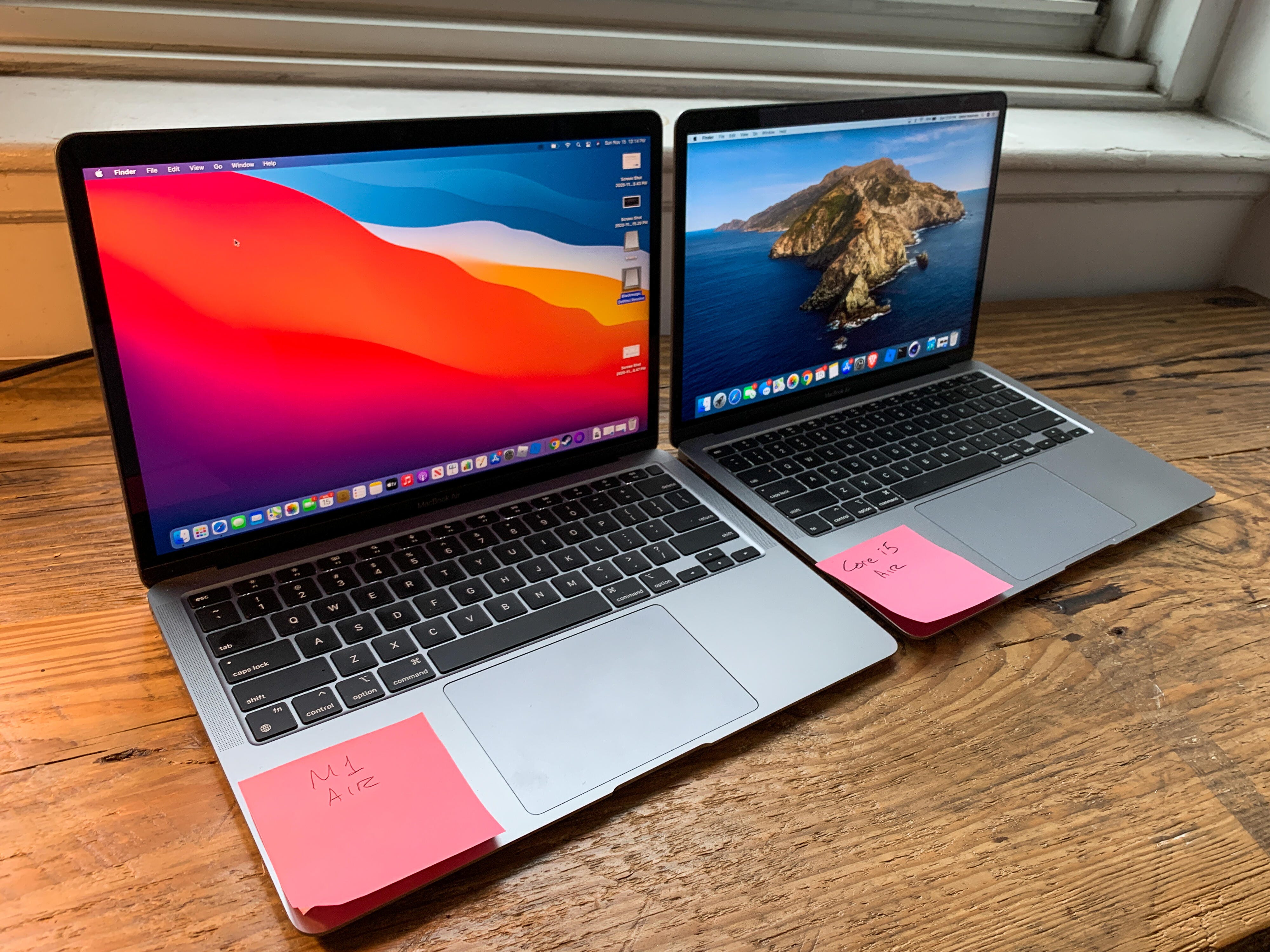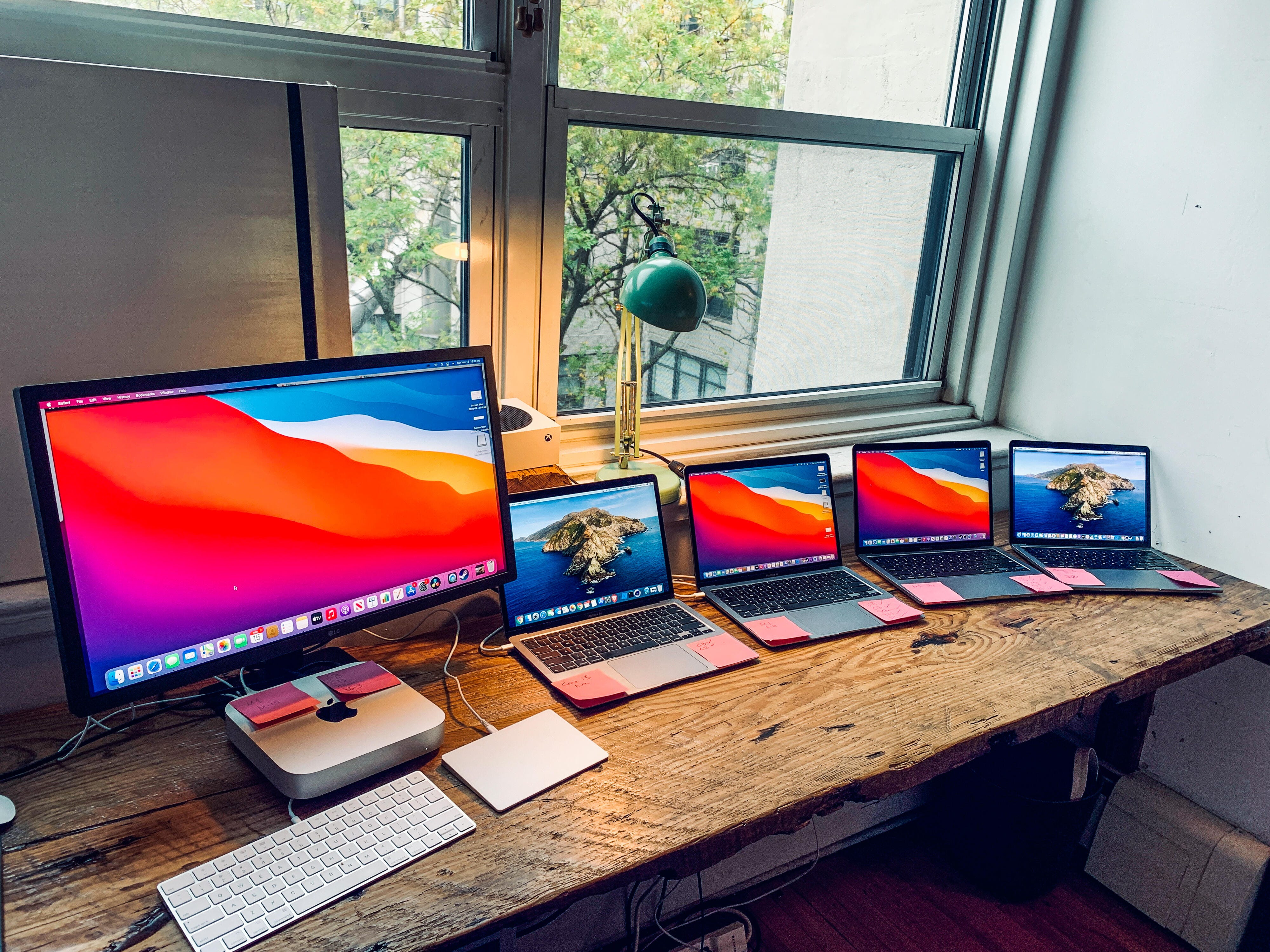MacBook Air M1 review: Big changes from Apple silicon and Big Sur
Going hands-on with the new M1-powered Apple MacBook Air feels very different from using any previous MacBook Air, even the early-2020 Intel version I tested alongside it. But that mostly comes from the new MacOS Big Sur experience, more than the hardware changes inside. Big Sur is a huge change for the Mac, with new visual flair, new controls and new ways of interfacing with your Mac. Once you account for the big OS update, the day-to-day experience will be familiar to anyone who has used a recent MacBook Air. That, by itself, is a big point in favor of the theory that switching Macs, especially the MacBook Air, from Intel CPUs to the new Apple-designed M1 system-on-chip will be overall a smooth transition.
Like
- Big boost to battery life
- Performance in benchmark tests shows the M1 Air easily outperforming Intel versions
- Fanless design runs cool and quiet
Don’t Like
- No external design or feature changes
- App compatibility is an issue for early adopters
- No mobile broadband options, 5G or otherwise
For such a popular laptop — I often call the MacBook Air the most universally useful laptop you can buy — continuity of experience is incredibly important. That’s true for Air users, who are usually looking for a sleek, reasonably priced machine that just works, as well as for those who use MacBook Pro ($2,249 at Adorama) laptops, the iMac, the Mac Mini or the Mac Pro for professional design, editing, photography or music work. Right now, only part of the Mac line is switching to Apple silicon. The rest, I’d expect to come sometime in the next year.
A familiar experience
There are a couple of things working in the M1’s favor when it comes to continuity of experience. The first is that much of what we do on our computers, again especially for the typical MacBook Air buyer, is done online, through cloud-based and browser-based tools.
Email, social media, shopping, video streaming, even workplace collaboration through Slack or other online tools — it’s all cloud- or browser-based, and for the most part highly platform-agnostic. The differences between the Mac and Windows capabilities of most laptops have narrowed significantly with this shift, and it’s rare — although not unheard of — that a casual or mainstream user runs into the old problem of not having the right OS for the tool they need.
Read more: Testing the entire new Apple Mac M1 lineup
In situations like the above, the new M1 MacBook Air feels very much like an Intel MacBook Air, which is a big selling point to anyone concerned about the wholesale platform change.
The Rosetta factor
Assisting in this is the Rosetta 2 emulation technology, which automatically installs itself the first time you attempt to install a non-native app (as in, an app not optimized for the M1 platform). So far, it’s let me install things like Adobe apps, including Photoshop and Premiere Pro, Steam for gaming and Google’s Chrome web browser.
Adobe adds its own warning message, letting you know you’re still installing and running the Intel versions of these programs while the M1-native versions are being worked on. A version of Lightroom is coming later in 2020, Photoshop and other apps are not coming until sometime in 2021. As Adobe apps and Macs really go hand in hand, it’s a bit shocking to me that zero Adobe apps are ready in their native forms on Day 1 of the M1 era. I’d have suspected Apple would keep a team of Adobe engineers chained in the basement of 1 Apple Park Way to make sure at least Photoshop or Illustrator could be a Day 1 native app.
That said, the emulated versions worked fine. Some of my colleagues would never deign to use Photoshop on a MacBook Air. I’ve used it for minor picture editing for years and the emulated version felt as robust as the native version on my Core i5 Air.

The new M1 Air next to the 2020 Intel Core i5 Air.
Dan Ackerman/CNET
One disappointment was that Mac gaming remains, much as it ever was, an afterthought. After some big claims about cult favorite new RPG Baldur’s Gate 3 running on M1 Macs, I could not get the Mac version to run via Steam — I got an error message on each of the M1 Macs I tested. Larian, developer of BG3, tells me that it’s working on a Rosetta-ready patch for the Steam version of the game right now.
Emulating software, especially games, is always a roll of the dice, but at least that’s the only app I tried that wouldn’t even launch in Rosetta mode. That said, the Steam interface itself ran sluggishly. I hope there’s a native version of that in the not-too-distant future as well.
Testing several other MacOS-compatible games from my Steam and GOG.com libraries, I got two out of six to work, so at the moment, I’d consider this even less of a gaming-friendly machine than its predecessor, but hopefully that’s an issue that can be patched or updated away soon.
But I wouldn’t call that a dealbreaker (unless you’re specifically buying a new Mac to play Baldur’s Gate 3 right now…). The truth is, the x86 app compatibility on the M1 is night and day different from my experience on Arm-based Windows PCs, including similarly high-end ones like the Surface Pro X. Those Arm-based PCs simply refuse to run all but a modest handful of software and while I like a lot about the Surface Pro X, it’s a productivity stopper that got in my way a lot. It was impossible to ever really forget you were using a non-Intel computer, while with the M1 MacBook Air, it was (almost) never an issue.
Call me a fan of fanless
Of the three new M1 Macs, the MacBook Air is the most different from its predecessor. That’s because the system is finally truly fanless, replacing the cooling fans with an aluminum heat spreader inside, as well as taking advantage of the highly efficient M1 chip, which Apple says will produce less heat, do more work per watt and generally outperform even high-end Intel Macs.
If you’ve never thought of the MacBook Air as a particularly loud laptop, try letting your 9-year-old play Roblox on it for a while; the fan really kicks in. Having a fanless version — something still rare even in ultrathin Windows laptops — is a big internal change.
The M1 version inside the Air is nearly identical to the ones in the MacBook Pro and Mac Mini. On paper the only difference is that the base model has a seven-core GPU on the SOC versus eight GPU cores in the higher-end M1 machines (including in the higher-end M1 Air config). Previously, there was a lot more daylight between the MacBooks, with the default $999 MacBook Air using a relatively wimpy Intel Core i3 CPU.
That’s a huge vote in favor of the Air versus the Pro if you’re looking for the most performance for the least money. Considering the entry-level $999 (£999, AU$1,599) M1 MacBook Air and $1,299 (£1,299, AU$1,999) M1 MacBook Pro are both machines with 8GB RAM and 256GB solid-state drives, I know which one I’d suggest as your starting point. For the extra $300 on the Pro, you’re getting a slightly brighter screen; the Touch Bar (even as the Air retains the best Touch Bar feature, the Touch ID fingerprint sensor); a few more hours of battery life (according to Apple’s claims); and a larger body with “active cooling,” otherwise known as a fan, which can allow the M1 MacBook Pro to run at peak speeds for longer without throttling down.
Considering the similar benchmark scores, there’s a strong case to be made for sticking with the new MacBook Air and throwing in another $200 for either 16GB of RAM or a 512GB SSD. Also worth noting, the M1 versions of the MacBook Pro have the same set of two Thunderbolt/USB 4 ports. You’ll need an upgraded Intel version of the Pro (starting at $1,799) to get back up to four ports.
In my hands-on with all three new Macs, you can find more performance and testing details, and find out why the little Mac Mini may be my favorite Mac right now.

Comparing the new M1 Macs with their Intel counterparts at the CNET Labs Brooklyn outpost.
Dan Ackerman/CNET
That’s probably the biggest letdown of the new Air — it’s new on the inside, not so much on the outside. Still just two ports. No edge-to-edge screen. No 5G. No touchscreen. Basically, all the things people prognosticate about in new-MacBook-Air prediction lists remain hypothetical. This is a transitional product. Once the new platform and software compatibility are well-established, design and feature changes may follow.
M1 Macs vs. Intel Macs
| Geekbench 5 single-core | Geekbench 5 multicore | Cinebench R23 multicore | |
|---|---|---|---|
| M1 Mac Mini | 1743 | 7704 | 7796 |
| M1 MacBook Air | 1731 | 7518 | 6822 |
| M1 MacBook Pro | 1723 | 7457 | 7772 |
| Core i5 MacBook Pro (13-inch Spring 2020) | 1184 | 4143 | 4703 |
| Core i5 MacBook Air (Spring 2020) | 1142 | 2912 | 2635 |

-3.png?width=698&height=393&name=blog%20image%20Salima%20(1)-3.png)